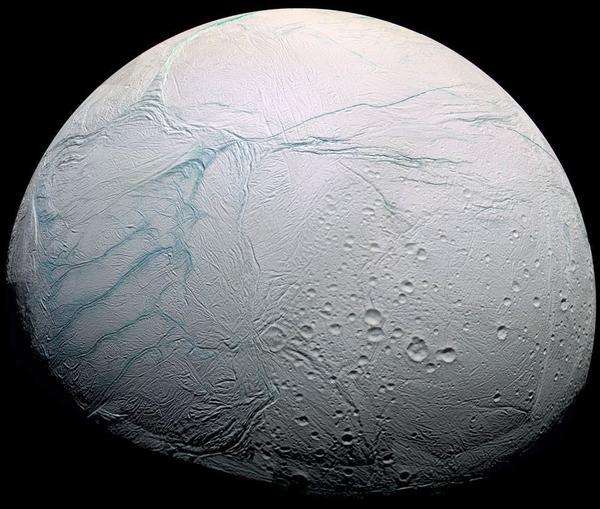Potential Life on a Saturn Moon
 Hydrothermal vents on a Saturn moon are so similar to life-ridden hydrothermal vents on Earth, scientists think they may find life up there, says a report in Nature.
Hydrothermal vents on a Saturn moon are so similar to life-ridden hydrothermal vents on Earth, scientists think they may find life up there, says a report in Nature.
In particular, hydrothermal vents in a sub-surface ocean on the Saturn moon Enceladus spew chemicals into Saturn’s rings that are eerily like chemicals spewing from the mid-Atlantic Ocean hydrothermal “Lost City” vents—which in turn are like chemicals, it is thought, from which life on earth originally sprang.
The discovered chemicals are “very good for life,” NASA astrobiologist Chris McKay told Bioscience Technology. A key product of the water-on-rock reactions seen on Enceladus “is hydrogen, and this is candy for microorganisms. All together, the data may make a strong case that the ocean down there is habitable, rich in organics and nutrients, and rich in energy in the form life can use.”
In an earlier 2014 study, McKay, uninvolved with the recent Nature report, called Enceladus “the best astrobiology target in the solar system.” Astrobiology is the study of earth life, in extreme environments, that may mirror extraterrestrial life.
The new work
University of Colorado astrophysicist Sean Hsu, a leader of the team behind the new report, gauged the pH, salinity, and temperature of the ocean on Enceladus by analyzing a Saturn ring.
In 2005 scientists discovered 125-mile-high icy geysers on Enceladus that were clearly the source of many particles in Saturn’s outer ring. With the mass spectrometer of the Cassini orbiter, they discovered the particles were made largely of silica apparently from evaporated geyser-flung saltwater—thus, from Enceladus’ potentially warm ocean.
The size and makeup of the silicate particles gave their origin away. For the uniformly small size of the clumps revealed the water was slightly less salinic than that of earth’s oceans today, and possessed a pH slightly greater than that of earth’s oceans before the industrial revolution. It also indicated the presence of hydrothermal vents at least 200 degrees F.
The vent-warmed waters were made of carbon dioxide, nitrogen, methane, and other chemicals necessary for earth life. It all indicated Enceladus may resemble the life-rich Lost City hydrothermal area.
As the heat in the vents is powered by gravitational friction generated by Saturn and its other moons—not a hot core, like ours—scientists don’t know how long the hydrothermal activity has gone on. But they are optimistic NASA will launch a new mission to answer that question, and many others—including whether there is, indeed, life up there.
Hsu told Bioscience Technology that “the most surprising” finding his team made was that “the interior of Enceladus is still warm at present time. For an object as small as Enceladus, the residual heat left from the formation is expected to have been dissipated a long time ago, meaning that Enceladus should be frozen. Tidal heating should be the major cause, but there is still quite a lot we do not know, including how long has Enceladus been active and how stable it has been.”
The Lost City comparison is apt, he said. “The formation of individual nano-silica particles indicate an alkaline environment. So, regarding the fluid pH and reaction temperature, we think the Lost City hydrothermal field is the best analog on Earth. The rock composition may play the dominant role here.”
There is more coming, both in the near-future and beyond, Hsu said. “Regarding observation, there are three more targeted Enceladus encounters coming up at the end of this year. Two of them focus on ‘remote sensing’ measurements such as infrared measurements to constrain the heat output. But one is diving deeper into the plume than ever before. The composition of ice grains and vapor will be measured with the highest quality possible for Cassini’s instruments.”
So in the near future, Hsu told Bioscience Technology, “there is a chance that we might get a better picture about heat sources and hydrothermal activities. But the real question regarding how good the chances are for life on Enceladus will likely be answered only by future missions with a dedicated, state-of-the-art payload.”
Such a payload may include “a modern ice-grain analyzer that we are already developing in our labs….On the other hand, I think it is important to carry out more hydrothermal experiments to have a systematic understanding. This will not only benefit our knowledge about the subsurface oceans, but also be useful for future mission design and instrument development…Currently there is no mission planned to revisit the Saturnian system. But there are several mission concepts that have been proposed to ESA (European Space Agency) and NASA."
MaKay told Bioscience Technology the new results "were not a surprise—or one could say they were an incremental surprise. The Cassini mission and the CAPS instrument in particular have been gradually revealing the nature of the subsurface ocean on Enceladus. The earlier indication of salt, and other results published over the years, have pointed toward a hot water rock reaction. So this was just confirmation of the result.”
The Lost City hydrothermal field, he agreed, “is a very good Earth analog. I find it a compelling story.”
McKay also agreed that “to confirm that there is life in the plume would require another mission. Cassini can't do it. It may require a sample return.”

